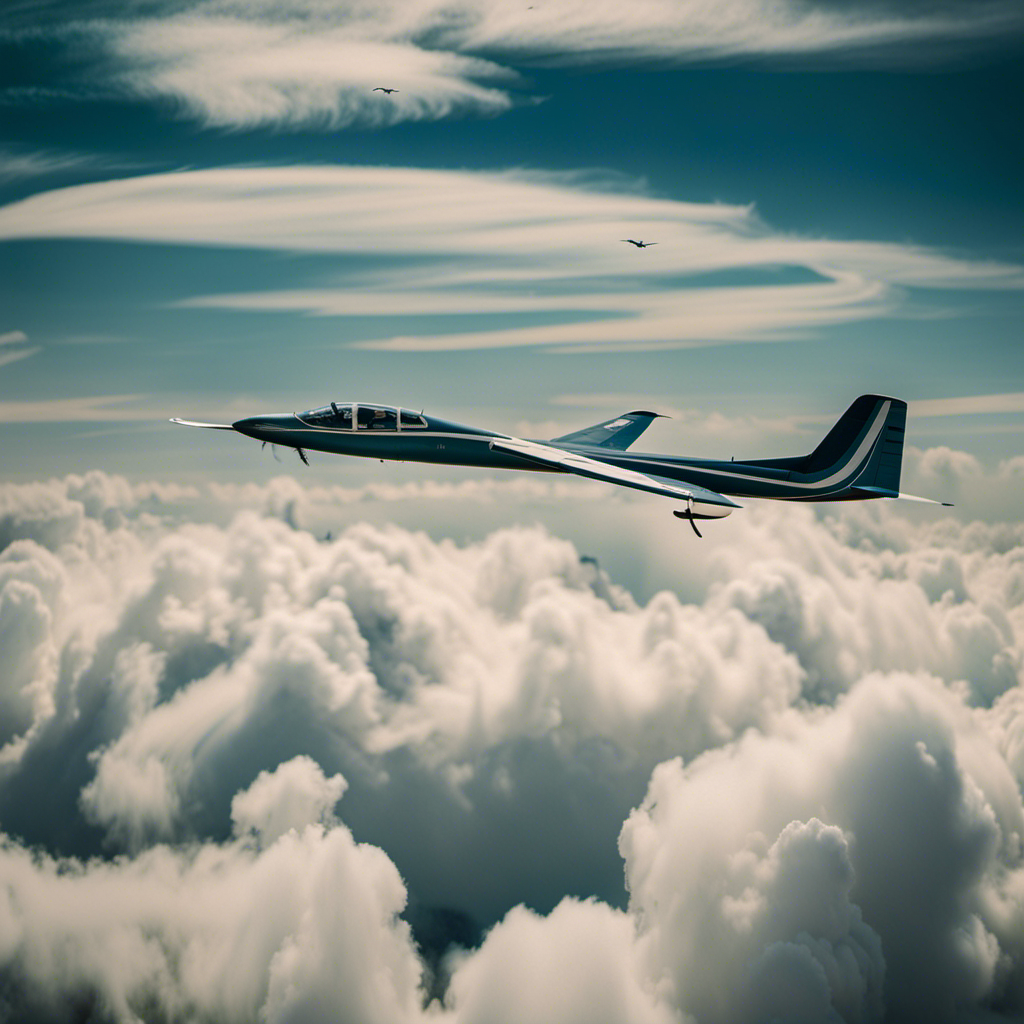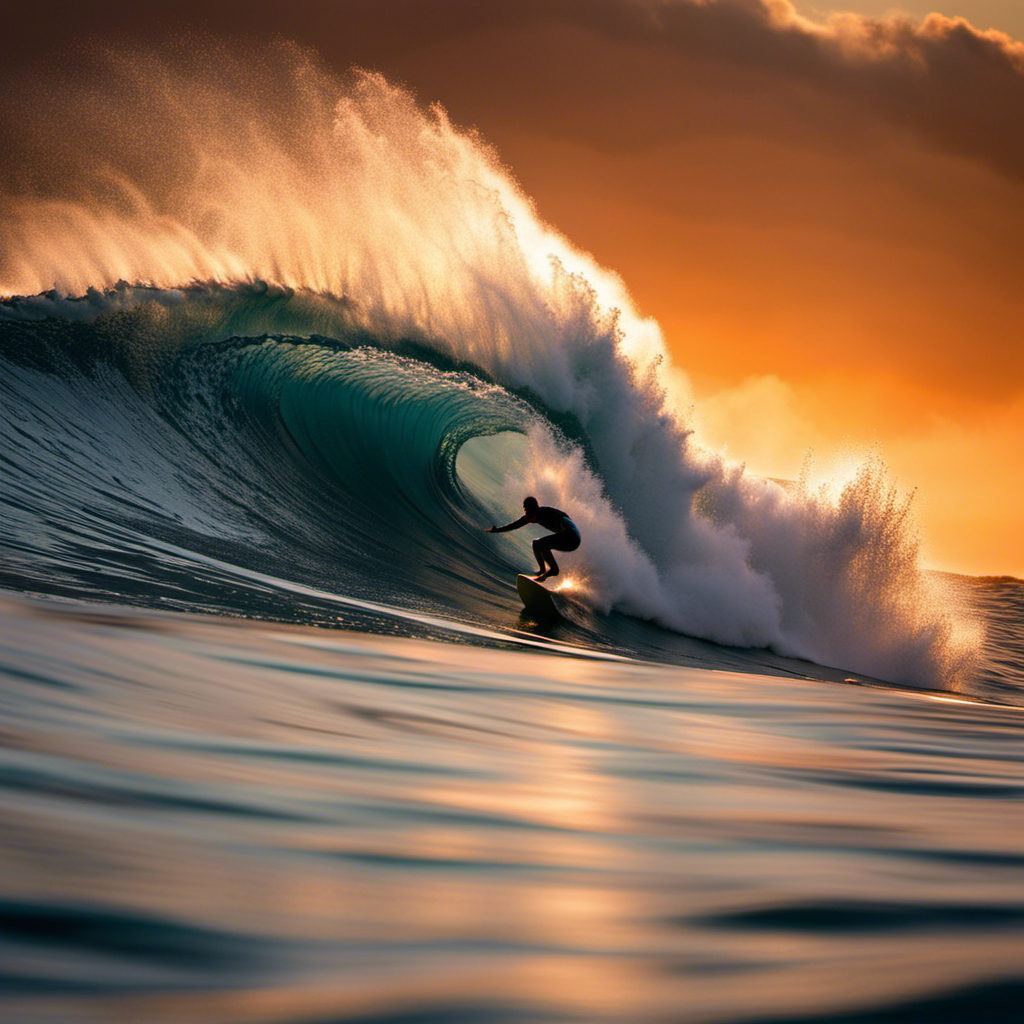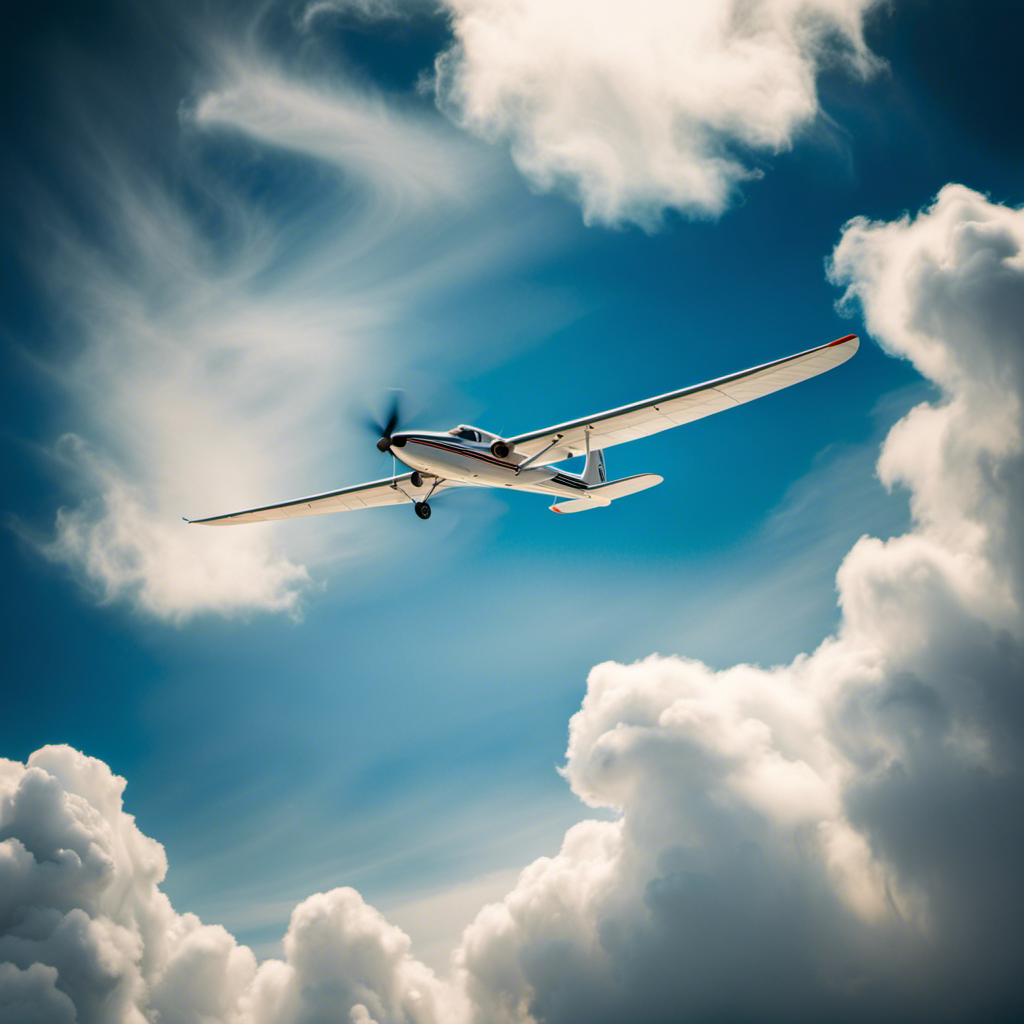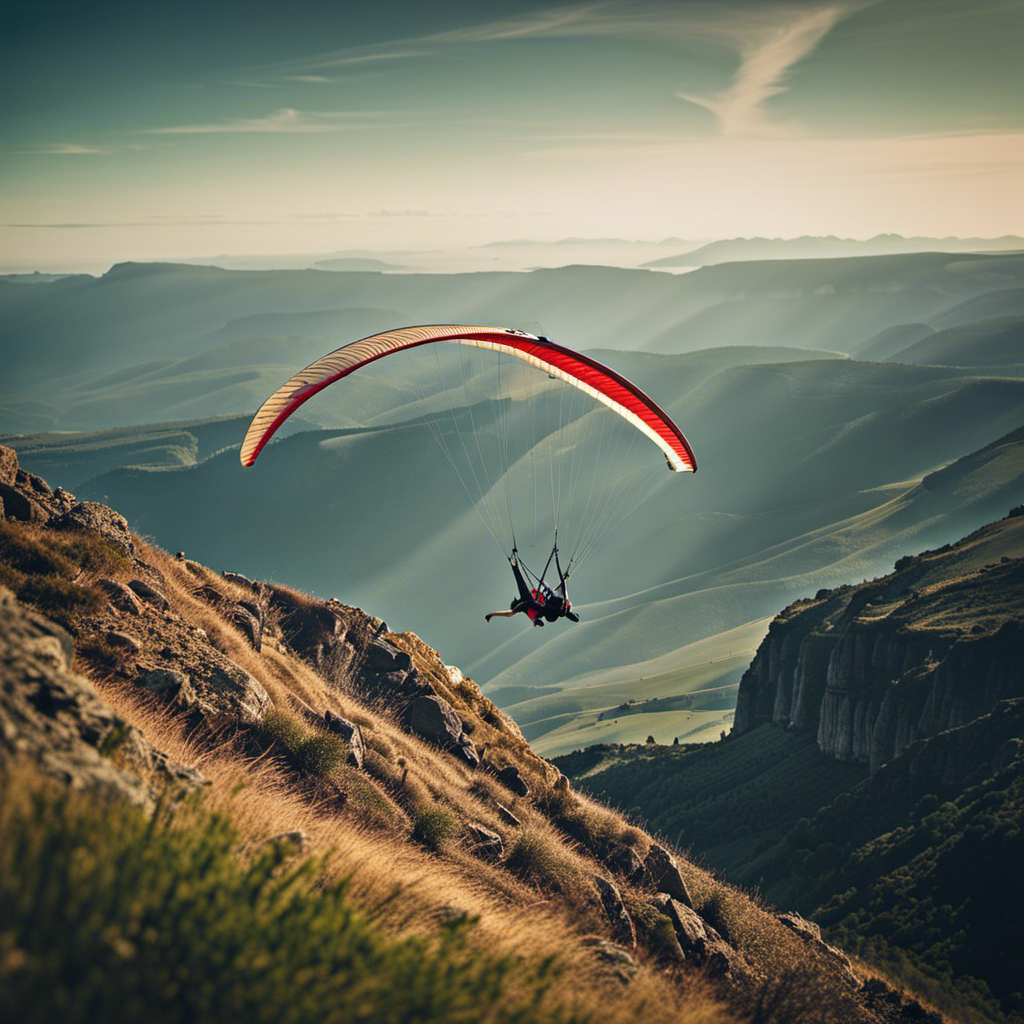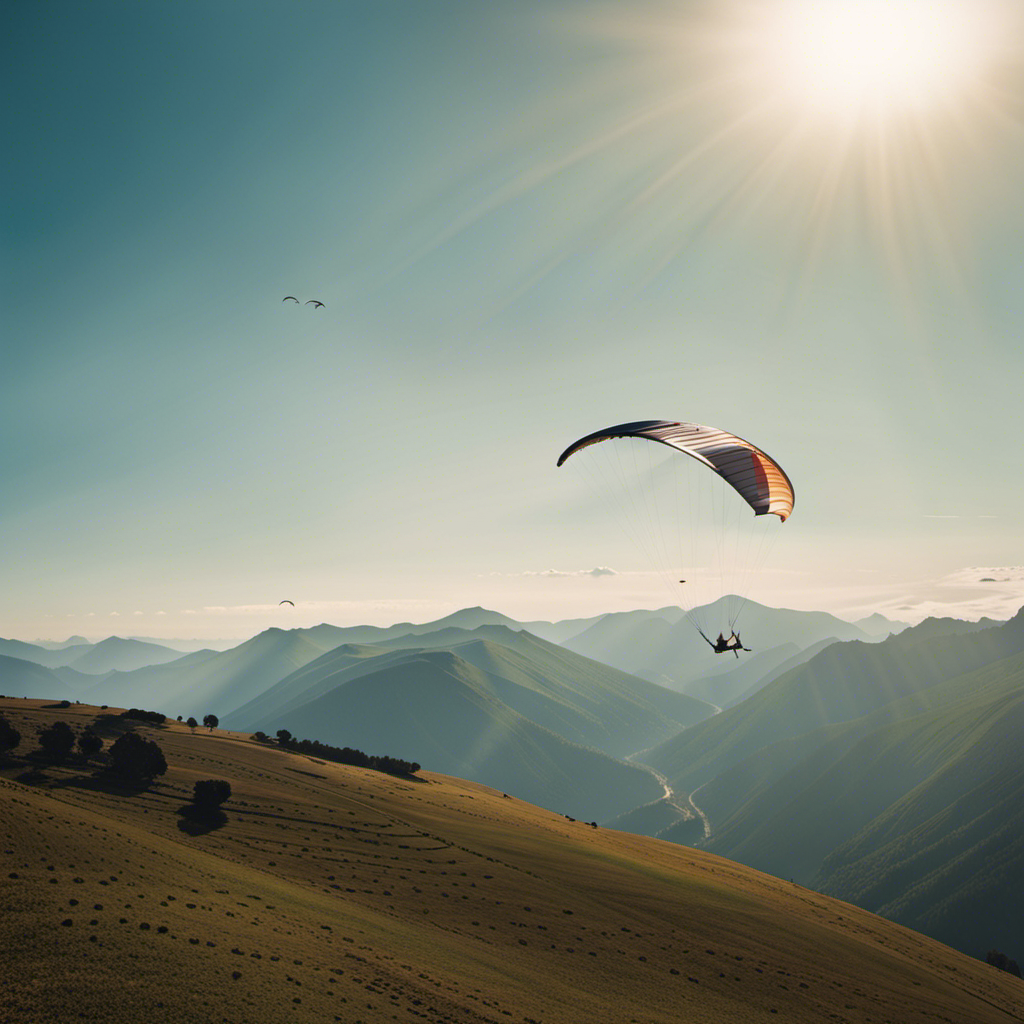You may be wondering: How is it possible for a glider to fly into the wind? It may seem counterintuitive, but the key lies in the intricate aerodynamics of these remarkable aircraft.
In this article, we will delve into the science behind glider flight, exploring concepts such as lift and drag, wingtip vortices, and the utilization of rising air currents.
We will also examine the techniques employed by glider pilots to control direction and the factors that influence glider design and performance.
So, buckle up and prepare to have your understanding of glider technology taken to new heights.
Key Takeaways
- Gliders can utilize rising air currents, such as thermal lift, ridge lift, wave lift, and convergence lift, to fly against the wind.
- Precise control and analysis of the glider’s position optimize ridge soaring, which involves flying along the ridge of a hill or mountain.
- Understanding wind patterns, including wind direction, speed, and wind shear, is crucial for successful glider flying and must be considered during flight planning.
- Advancements in glider technology, such as electric and hybrid gliders, offer cleaner and quieter flight options, longer flight times, reduced carbon emissions, and lower operating costs.
Understanding Glider Aerodynamics
Understanding how gliders fly against the wind is key to comprehending glider aerodynamics. Gliders achieve this by optimizing lift and stability.
Lift optimization is crucial for gliders to stay airborne for extended periods. By utilizing the shape and design of their wings, gliders generate lift, which counteracts the force of gravity. This lift is maximized by carefully considering factors such as wing shape, angle of attack, and airfoil design.
Glider stability is another important aspect of their flight against the wind. Stability is achieved by ensuring that the aircraft remains in a balanced state, resisting any disturbances from external forces. This is accomplished through the careful placement of the center of gravity and the incorporation of stabilizing features such as vertical and horizontal stabilizers.
Understanding these principles sets the foundation for comprehending the complex interplay of lift and drag in glider flight.
Lift and Drag in Glider Flight
Lift and drag are key factors in how gliders can navigate through the air. Understanding lift is crucial to comprehending glider flight dynamics. Lift is the force that opposes the weight of the glider and enables it to stay airborne. It is generated by the shape of the wings and the angle of attack.
On the other hand, drag is the resistance that opposes the forward motion of the glider. It is caused by factors such as air friction and the shape of the glider. By managing these two forces, glider pilots can control their altitude and speed during flight.
Now, let’s delve deeper into the fascinating topic of glider wings and wingtip vortices.
Glider Wings and Wingtip Vortices
When considering the glider wings and their performance, two key factors come to mind: wing shape and angle of attack.
The shape of the wing plays a crucial role in determining the lift and drag characteristics of the glider. Additionally, the angle of attack, which is the angle between the wing’s chord line and the oncoming airflow, directly affects the lift generated by the wing.
Another important aspect to consider is the formation of wingtip vortices, which are caused by the pressure difference between the upper and lower surfaces of the wing. These vortices can have a significant impact on the glider’s induced drag, which is the drag that is generated as a result of the production of lift.
Wing Shape and Angle of Attack
The shape and angle of attack of a glider’s wings affect its ability to fly against the wind. Here’s how:
-
Wing Loading: The wing shape determines how much weight the glider can carry. A higher wing loading means the glider has more weight per unit area of the wings, which can affect its ability to generate lift and fly against the wind.
-
Lift and Drag: The angle of attack of the wings determines the lift and drag forces. By adjusting the angle of attack, the pilot can control the balance between lift and drag, optimizing the glider’s performance against the wind.
-
Aerodynamic Efficiency: The shape of the wings, including their aspect ratio and airfoil profile, affects the glider’s aerodynamic efficiency. A more streamlined shape reduces drag and improves the glider’s ability to penetrate through the wind.
-
Stall Characteristics: The wing shape and angle of attack also influence the glider’s stall characteristics. A well-designed wing allows for a gentle and predictable stall, ensuring the glider remains controllable even in turbulent wind conditions.
Understanding the impact of wing shape and angle of attack on glider performance is crucial for pilots to maximize their efficiency and safety in flying against the wind.
Now, let’s delve into the fascinating world of wingtip vortices and induced drag.
Wingtip Vortices and Induced Drag
To understand wingtip vortices and induced drag, you need to know how wing shape and angle of attack affect a glider’s performance.
Wingtip vortices are created when air flows from the bottom of the wing to the top, resulting in a swirling motion at the wingtips. These vortices generate a downward force, known as induced drag, which opposes the glider’s forward motion.
The magnitude of induced drag depends on various factors such as wing span, airspeed, and weight. By reducing the wingtip vortices through wingtip devices, such as winglets, the induced drag can be minimized, thereby improving the glider’s efficiency.
This reduction in drag allows the glider to maintain a higher speed and stay airborne for longer durations. By understanding how to mitigate wingtip vortices and induced drag, glider pilots can optimize their flight performance and maximize their time in the air, ultimately leading to more successful gliding experiences.
Now, let’s explore another crucial aspect of glider flight: utilizing rising air currents.
Utilizing Rising Air Currents
Gliders can use rising air currents to fly against the wind. This technique, known as soaring, allows glider pilots to stay aloft for longer periods of time and cover great distances. Here are four key factors that contribute to the effectiveness of utilizing rising air currents:
-
Thermal Lift: When the sun heats the Earth’s surface, it creates pockets of warm air that rise. Glider pilots can detect these thermals and use them to gain altitude.
-
Ridge Lift: When wind encounters a hill or mountain, it is forced upwards. This creates a ridge of rising air that gliders can ride along, effectively flying against the wind.
-
Wave Lift: In certain weather conditions, wind can create standing waves in the atmosphere. Glider pilots can ride these waves, similar to how a surfer rides ocean waves, to gain altitude and fly against the wind.
-
Convergence Lift: When two air masses with different characteristics meet, they can create a convergence zone with rising air. Glider pilots can exploit this lift to fly against the wind.
By harnessing these rising air currents and understanding wind patterns, glider pilots can navigate the skies with precision and efficiency.
Now, let’s delve into the various glider pilot techniques that maximize the use of these air currents.
Glider Pilot Techniques
You can enhance your glider piloting skills by mastering various techniques that maximize the use of rising air currents.
Glider soaring relies heavily on the ability to find and exploit thermals and updrafts. One technique is called ‘thermalling,’ where the pilot circles within a thermal to gain altitude. By observing the movements of birds and the changing landscape, pilots can locate areas where thermals are likely to form.
Another technique is ridge soaring, where the glider flies along the ridge of a hill or mountain, taking advantage of the upward wind that is deflected by the terrain. These techniques require precise control and analysis of the glider’s position and attitude in order to optimize the use of rising air currents.
Understanding wind patterns is crucial in glider piloting as it dictates the availability and strength of these updrafts. By studying the wind’s direction and speed, pilots can plan their flights and make strategic decisions to fly against the wind.
Understanding Wind Patterns
When it comes to glider flying, understanding wind patterns is crucial. As a pilot, I need to pay close attention to wind direction and speed in order to make informed decisions during flight.
Additionally, I can utilize wind shear and ridge lift to my advantage. By using these phenomena, I can gain altitude and maximize my glider’s performance.
Wind Direction and Speed
To fly against the wind, it’s important to know the direction and speed of the wind. Understanding wind patterns is crucial in achieving this. Here are some key factors to consider:
-
Wind patterns:
-
Local topography: The shape of the land affects how the wind flows. Hills and valleys can create turbulence and eddies.
-
Atmospheric conditions: Changes in temperature and pressure can cause variations in wind speed and direction.
-
Wind shear:
-
Vertical wind shear: This occurs when there is a significant change in wind speed or direction with altitude. It can affect the performance of a glider and must be taken into account during flight planning.
-
Horizontal wind shear: This refers to changes in wind speed or direction over a horizontal distance. It can create turbulence and affect glider control.
Utilizing Wind Shear and Ridge Lift
By understanding wind patterns and utilizing wind shear and ridge lift effectively, you can enhance your gliding experience and overcome the challenges posed by varying wind conditions.
Wind shear refers to the change in wind direction or speed with altitude. This phenomenon can be harnessed to your advantage when flying a glider. By recognizing and exploiting areas of wind shear, you can adjust your flight path to optimize your speed and efficiency.
Ridge lift, on the other hand, is created when the wind encounters a hill or mountain and is forced to rise. This upward motion can provide an additional source of lift for gliders. When combined with thermal lift, which is generated by the heating of the Earth’s surface, gliders can stay aloft for extended periods of time.
Controlling Glider Direction
Although gliders cannot actively change direction like powered aircraft, they can adjust their flight path using various techniques.
One of the key components in controlling glider direction is the rudder. By manipulating the rudder, pilots can control the yaw of the glider, which refers to its side-to-side movement. The rudder works by deflecting the airflow, causing the glider to turn in the desired direction. To turn to the left, for example, the pilot will apply left rudder. By varying the amount of rudder input, the pilot can make subtle adjustments to the glider’s course and maintain control during flight.
This ability to control yaw is essential when flying against the wind or when navigating through changing atmospheric conditions.
Now, let’s explore how glider design and performance factors contribute to their ability to fly against the wind and maximize their efficiency.
Glider Design and Performance Factors
After discussing how the glider’s direction can be controlled, let’s now delve into the design and performance factors that affect the stability and overall flight characteristics of a glider.
When it comes to glider stability and performance, several key factors come into play:
- Wing design: The shape and size of the wings greatly impact how the glider behaves in flight.
- Weight distribution: Proper weight distribution ensures optimal balance and stability during flight.
- Center of gravity: The location of the center of gravity affects the glider’s stability and maneuverability.
- Control surfaces: The control surfaces, such as the rudder and elevators, allow the pilot to control the glider’s movements.
By carefully considering these factors, glider designers and pilots can optimize the stability and performance of the aircraft, allowing for safe and efficient flight.
Now that we have explored the various design and performance factors, let’s move on to discussing the essential safety measures and precautions one must take when flying a glider.
Safety Measures and Precautions
To ensure a safe and enjoyable flight, it is important for glider pilots to follow essential safety measures and take necessary precautions. Adhering to proper safety guidelines is crucial in minimizing potential risks and ensuring the well-being of both the pilot and the glider.
Before each flight, it is essential to thoroughly inspect the glider for any signs of damage or wear. Additionally, pilots must carefully consider weather conditions, such as wind speed and direction, to determine if it is suitable for flying. It is imperative to avoid flying in adverse weather conditions, such as thunderstorms or high crosswinds, to prevent accidents or loss of control.
By meticulously following safety guidelines and considering weather conditions, glider pilots can enhance the safety of their flights.
Looking ahead, the future of glider technology holds exciting developments that will further enhance safety and performance in the skies.
The Future of Glider Technology
As we look towards the future of glider technology, two key areas of advancement come to mind.
Firstly, electric and hybrid gliders are gaining popularity due to their environmental benefits and the potential for longer flight times. These gliders offer a cleaner and quieter alternative to traditional gliders powered by fossil fuels. With advancements in battery technology, electric and hybrid gliders can now stay aloft for extended periods, opening up new possibilities for cross-country flights and exploration.
Secondly, advancements in materials and aerodynamics are shaping the development of gliders. New materials, such as carbon fiber composites, are being used to create gliders that are more efficient and lightweight. These advancements not only improve the glider’s performance but also increase its maneuverability and speed. With sleeker designs and improved wing profiles, gliders can now reach higher speeds and perform more precise maneuvers, enhancing the overall experience of gliding.
These developments in electric and hybrid gliders, as well as materials and aerodynamics, offer exciting possibilities for the future of gliding. The combination of cleaner and more efficient propulsion systems, along with lighter and more aerodynamic designs, will undoubtedly shape the way we experience this exhilarating sport. With longer flight times, improved performance, and enhanced maneuverability, gliding will continue to captivate and inspire pilots and enthusiasts alike.
Electric and Hybrid Gliders
Electric and hybrid gliders are revolutionizing the world of aviation by offering increased energy efficiency and reduced environmental impact. These innovative aircraft use a combination of electric motors and traditional gliding techniques to fly efficiently. Here are some key reasons why electric and hybrid gliders are gaining popularity:
-
Reduced carbon emissions: Electric and hybrid propulsion systems significantly reduce carbon emissions compared to traditional gliders powered by internal combustion engines.
-
Noise reduction: Electric motors produce much less noise than traditional engines, providing a quieter and more enjoyable flying experience.
-
Enhanced range: Electric and hybrid propulsion systems allow gliders to cover greater distances, thanks to their ability to recharge the onboard batteries during flight.
-
Lower operating costs: Electric and hybrid gliders require less maintenance and fuel costs, making them more economically viable in the long run.
-
Sustainable future: By embracing electric and hybrid technologies, we are taking a step towards a greener and more sustainable aviation industry.
As we delve into the advancements in materials and aerodynamics, we will explore how these innovations further enhance the performance and efficiency of electric and hybrid gliders.
Advancements in Materials and Aerodynamics
You’ll be amazed at how advancements in materials and aerodynamics have significantly improved the performance and efficiency of electric and hybrid gliders.
These advancements have revolutionized the way gliders are designed and built, allowing for lighter and stronger structures. The use of advanced composite materials, such as carbon fiber, has made it possible to create gliders that are not only lightweight but also extremely durable. These materials have high strength-to-weight ratios, which means they can withstand the forces of flight while still being lightweight.
In addition to materials, advancements in aerodynamics have also played a crucial role in improving glider performance. Through careful design and optimization, aerodynamic drag has been reduced, resulting in increased efficiency and longer flight times.
These advancements have made electric and hybrid gliders more accessible and practical, opening up new possibilities for sustainable aviation.
Frequently Asked Questions
What are the different types of rising air currents that gliders can utilize for sustained flight?
Thermal dynamics and ridge soaring are two types of rising air currents that gliders can utilize for sustained flight. Thermal dynamics involve warm air rising from the ground, while ridge soaring involves using wind deflected by a ridge or mountain to gain altitude.
How do glider pilots navigate through changing wind patterns during a flight?
Flying a glider involves using various techniques to navigate through changing wind patterns. By analyzing wind indicators and making adjustments to my flight path, I can effectively adapt to the wind patterns and ensure a smooth and controlled flight.
What are some key factors that affect the design and performance of a glider?
Design factors and performance factors are key considerations in glider design. Design factors include wing shape, wing loading, and control surfaces. Performance factors include glide ratio, stall speed, and maximum speed. These factors determine the efficiency and capabilities of a glider.
What safety measures and precautions should glider pilots take before and during a flight?
Before and during a flight, glider pilots must prioritize safety measures and pre-flight checks. Adhering to these protocols ensures a thorough assessment of equipment, weather conditions, and personal readiness, reducing the risk of accidents and enhancing overall flight safety.
What advancements or developments in glider technology can we expect in the future?
In terms of advancements and developments, we can expect improvements in material technology to enhance glider performance and efficiency. Aerodynamic design will also evolve to maximize lift and minimize drag, allowing for longer and more efficient flights.
Conclusion
In conclusion, the art of gliding against the wind is a fascinating dance between man and machine.
As the glider gracefully soars through the air, defying gravity with its sleek wings, it becomes a metaphorical bird of prey, hunting for rising air currents to sustain its flight.
The pilot, like a master puppeteer, skillfully manipulates the controls, adjusting the glider’s direction with precision.
With advancements in glider design and technology, the future holds endless possibilities for this elegant form of aviation.
So next time you see a glider soaring effortlessly through the sky, take a moment to appreciate the beauty and ingenuity behind this remarkable feat.
With a heart that soars as high as the skies, Aria, affectionately known as “Skylark,” is the driving force behind Soaring Skyways. Her journey into the gliding world began as a young dreamer gazing up at the soaring birds, yearning to experience the weightlessness and freedom they embodied. With years of experience both in the cockpit and behind the scenes, Aria’s commitment to the gliding community is unwavering.
